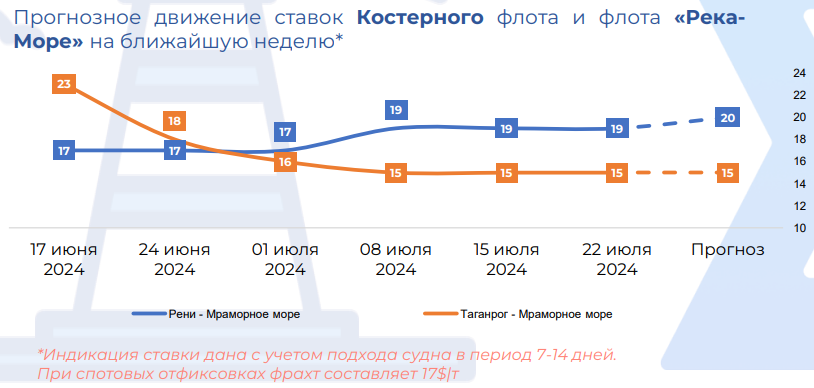In the Black Sea, the freight market remains under pressure. Despite an increase in grain offers from Ukraine, the excess of vessels exceeds demand for transportation. This prevents the growth of freight rates on popular grain routes. The main obstacle is a lack of offers for steel, coal, fertilizers and European grains. Even with the outflow of the fleet, shipowners cannot raise rates due to the excess of vessels. Shipowners are often forced to lower rates to book cargo. This is especially noticeable on popular routes, where rates have fallen by $0.5-1/t. A limited supply of steel and fertilizers also keeps the situation from improving. The resumption of fertilizer production in Egypt may boost shipments in August. Shipowners and grain traders hope for increased demand for Ukrainian and European grain in August, but significant rate increases are unlikely without higher export prices. Forecasts remain cautious. Without a significant increase in grain exports from Ukraine, Romania, Bulgaria and Russia, the situation is not expected to improve.
In the Mediterranean Sea, the freight market is also facing difficulties. The surplus of vessels is putting pressure on freight rates, forcing shipowners to reduce rates to load vessels. Shipowners often accept rate reductions of $0.5-1/t to book cargoes. This is especially noticeable on routes related to steel and construction materials transportation. Demand for transportation in the Mediterranean is low. Turkish steel producers are experiencing sales problems, which negatively affects the market. Some shipowners are refocusing on routes between the Eastern Mediterranean and Marmara, minimizing ballast crossings and partially covering operating costs. Forecasts remain cautious. Without an increase in freight demand, freight rates in the Mediterranean are unlikely to rise significantly. Shipowners and brokers are hoping for active grain exports from Ukraine and Egypt, which may improve the market. However, excessive tonnage and low demand limit any improvement.
In the Azov Sea, the freight market shows signs of revival. Slight growth in activity in grain and agro-products transportation resulted in an increase in freight rates. The number of wheat shipments to Egypt and Turkey has increased, which has positively affected the market. Shipowners are trying to raise rates, trying to get $18-20/t for the transportation of 3,000 tons of corn or peas from Rostov or Azov to Marmara. However, Charterers are targeting rates of $16-16.5/t. Negotiations are ongoing, and deals are concluded at different levels depending on voyage conditions. Demand for coal transportation from Azov to Samsun remains at $12/t. The overall situation is difficult due to excessive tonnage and lack of wheat imports to Turkey. This limits opportunities for significant growth in freight rates. Forecasts are restrained. Without an increase in demand for grain and coal transportation, freight rates in the Azov Sea are unlikely to grow. Market recovery is possible if wheat imports to Turkey resume and export prices for grains increase.

 +380 67 625 91 65
+380 67 625 91 65